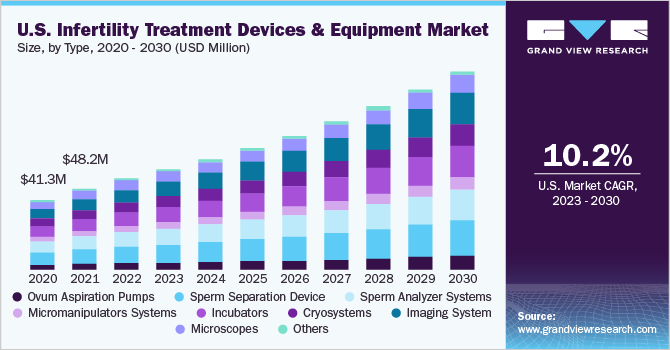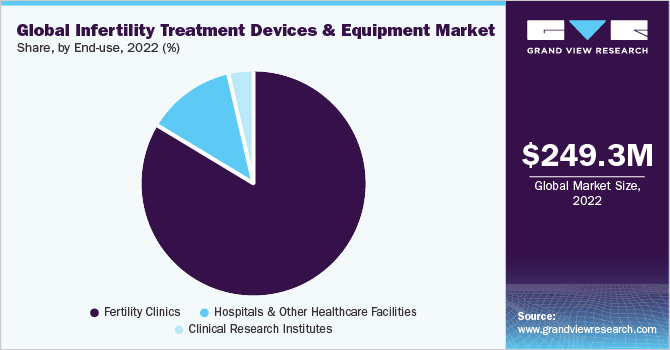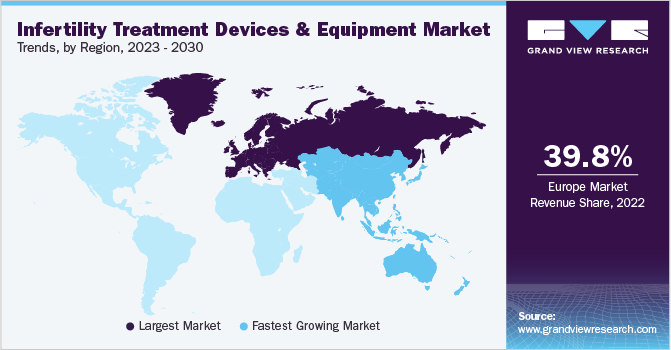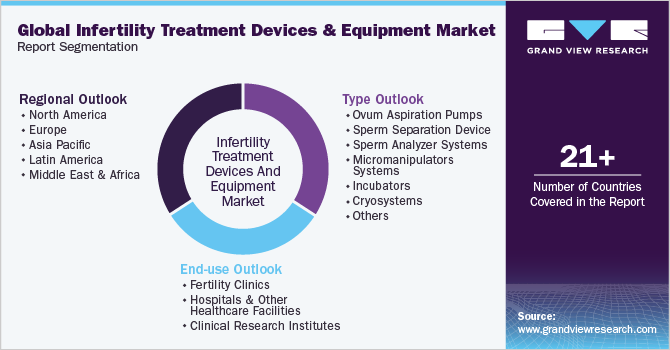- Home
- »
- Medical Devices
- »
-
Infertility Treatment Devices And Equipment Market ReportGVR Report cover
![Infertility Treatment Devices And Equipment Market Size, Share & Trends Report]()
Infertility Treatment Devices And Equipment Market Size, Share & Trends Analysis Report By Type, By End-use (Fertility Clinics, Hospitals & Other Healthcare Facilities, Clinical Research Institutes), By Region, And Segment Forecasts, 2023 - 2030
- Report ID: GVR-3-68038-142-9
- Number of Report Pages: 190
- Format: PDF, Horizon Databook
- Historical Range: 2018 - 2021
- Forecast Period: 2023 - 2030
- Industry: Healthcare
Report Overview
The global infertility treatment devices and equipment market size was valued at USD 249.34 million in 2022 and is expected to grow at a compound annual growth rate (CAGR) of 10.56% from 2023 to 2030. Over the last few years, infertility rates have been increasing across the globe. The use of Assisted Reproductive Technology (ART) by infertile couples is increasing by 5-10% per year. The CDC and the WHO monitor high infertility prevalence around the world. Currently, 46% of the global population lives in countries with low levels of fertility. Another 46% of the population lives in countries with intermediate fertility and the remaining 8% population lives in countries with high fertility. According to the UN , the global fertility rate is expected to decline to 2.4 by 2030 and 2.2 by 2050.

The rate of infertility is increasing around the world due to the rising prevalence of conditions such as erectile dysfunction and Polycystic Ovary Syndrome (PCOS). Significant changes in lifestyle and increasing preference of working women for conceiving at a later age may result in complications. Infertility in men is a result of various factors such as stress, alcohol consumption, changing lifestyle, and reduced sperm count & motility.
A constant increase in the incidence of infertility in both sexes is driving the market for infertility treatment devices and equipment. Fertility in women generally starts decreasing after the age of 30. The rate of infertility is especially higher in the late 30s and early 40s. Women aged over 35 are classified as having advanced reproductive age and are advised to opt for early investigations and treatments.
According to WHO, around 10% of women are directly or indirectly affected by infertility. Infertility affects around 12% of couples of reproductive ages, as one in every four couples suffers from infertility in developing countries. The WHO monitors the incidence of infertility across the globe in line with “WHO Reproductive Health Indicators: Guidelines for Their Generation, Interpretation and Analysis for Global Monitoring.”
Moreover, high adoption of Assisted Reproductive Technology (ART) is a significant driver for the infertility treatment devices & equipment market. The increasing awareness & acceptance of ART has led to a surge in demand for these procedures. According to a report by the Centers for Disease Control and Prevention (CDC), the use of ART has doubled in the past decade in the U.S. alone.
ART procedures, such as In Vitro Fertilization (IVF), Intracytoplasmic Sperm Injection (ICSI), and others, have become more accessible and affordable for couples who are struggling with infertility. These procedures have high success rates and are an attractive option for those who are unable to conceive naturally. For instance, according to the latest data from the Society for Assisted Reproductive Technology (SART), 301,523 ART cycles were performed in the U.S. in 2020, resulting in 73,602 live births.
The COVID-19 pandemic slowed the global economy owing to a high infection rate. The Brigham and Women's Hospital community has overcome various COVID-19 pandemic obstacles to become more resilient than ever. The Center for Infertility and Reproductive Surgery is adopting a careful approach to safely reintegrating its fertility patients, as the number of COVID-19 patients rapidly falls.
In response to the COVID-19 pandemic, scientific and professional fertility societies worldwide, such as the International Federation for Fertility Societies (IFFS), American Society of Reproductive Medicine (ASRM), European Society for Human Reproduction and Embryology (ESHRE), and the Canadian Fertility and Andrology Society (CFAS), issued specific guidelines for intended couples who were undergoing or willing to undergo fertility treatments.
Type Insights
Sperm separation devices dominated the market with 17.66% of the revenue share in 2022. Sperm separation devices are used in assisted reproductive treatments such as In Vitro Fertilization (IVF) and artificial insemination. In addition, the shelf life of these devices is lower than that of other capital equipment, such as incubators. Hence, these devices need to be replaced in a few years to maintain optimum productivity.
Sperm separation devices have the capability of isolating highly motile sperms with high DNA integrity from the semen sample. Microfluidic technology isolates healthy sperms, creating gradients. The sperm separation procedure eliminates the sperms with malformations, larger heads, or bent necks. The healthiest and strongest sperms get through the sperm separation arrays and are then collected at the end of the procedure.
Time-lapse imaging systems are used for safe and continuous embryo monitoring throughout the incubation period. These imaging systems have a built-in microscope that captures and analyses embryo development in high resolution, without disturbing the growth environment of the culture in the incubator.
With the help of time-lapse imaging systems, the best embryos can be selected by embryologists for the final transfer, based on the embryo development patterns visible in time-lapse images & videos. Time-lapse imaging systems prevent embryos from getting disturbed in the culture during their assessment. Hence, manual handling is eliminated, minimizing the risk of accidents, and improving cultural conditions.
End-use Insights
Fertility clinics accounted for the dominant revenue share of 83.28% in 2022. All types of infertility treatment procedures are performed at licensed fertility clinics. The treatment procedures involve consultation, which includes the determination of the causes of infertility, before initiating the procedures. In addition, fertility specialists can prescribe medications for fertility to increase the chances of conception.
Moreover, fertility clinics offer couples counseling and treatment plans based on the severity and causes of their infertility. ART centers need to comply with certain regulatory guidelines for operations. As per the statistics of CDC’s Fertility Clinic Success Rates Report 2020, there were 326,468 ART cycles performed at 449 clinics in the U.S. during the year, resulting in 75,023 live births and 79,942 live-born infants. In October 2022, Alife launched a new AI software to aid fertility clinics in optimizing & supporting decision-making during critical stages of IVF procedures.

In addition, some multispecialty hospitals offer ARTs, such as artificial insemination, IVF, and surrogacy. An increase in convenience and availability of various treatments in a single setting is contributing to the growing preference for hospitals by consumers. ART procedures offered by hospitals are generally expensive and require highly skilled staff. Hence, significant investments are required by hospitals to recruit dedicated staff for infertility treatments.
Regional Insights
Europe accounted for the largest market share of 39.84% in 2022. In Europe, the fertility rate has constantly been declining over the years. According to Eurostat: Demographic Statistics, in 2022, the fertility rate in Europe was 1.49 births per woman, compared to 2.7 in 1950. In addition, the number of couples reporting infertility has been increasing by 8-9% each year, making infertility a public health concern.
Moreover, the increasing number of market players and the launch of new products in this region are factors expected to boost the competitive rivalry among players. In September 2021, Rebecca Weiss, a German design graduate, received the James Dyson Award for a male contraceptive product known as COSO, that uses ultrasound waves to halt sperm regeneration for a short period of time. The device is designed to be a reversible contraceptive solution.

The demand for ART treatments is expected to grow exponentially in Asia Pacific, owing to the rise in fertility tourism, an increase in the number of international players focusing on entering the market in economically developing countries, and changing regulatory landscape. The Asia Pacific Initiative on Reproduction consists of a task force of clinicians and scientists involved in the monitoring and management of fertility and ART. It promotes awareness regarding ART & infertility and enhances infertility-related services in the region.
Increasing infertility rates and rising awareness about treatment options are expected to boost market growth in this region. The social stigma associated with ARTs is slowly decreasing in Asia Pacific. Japan, China, and India are the notable markets in this region. As per statistics from The World Bank Group, in 2021, the birth rate in the Asia Pacific fell to a population replacement level of 4.6 children per woman. The decline in the birth rate and the increase in the geriatric population are among the major factors expected to propel market growth in Asia Pacific during the forecast period.
Key Companies & Market Share Insights
The market is fragmented due to the presence of several multinational as well as local players. Moreover, the consolidation activities undertaken by multinational companies are estimated to increase competition amongst new and local market players. Some companies are adopting strategies such as acquisitions to strengthen their presence in other regional markets.
For instance, in December 2022, Hamilton Thorne Ltd. announced the acquisition of Microptic, S.L. The acquisition is likely to strengthen the company's footprint in computer-assisted semen analysis for IVF clinics and significantly expand expertise in the artificial intelligence-enabled product portfolio. Some of the prominent players in the global infertility treatment devices and equipment market include:
-
The Cooper Companies Inc.
-
Cook Medical
-
Vitrolife
-
DxNow
-
Eppendorf AG
-
AB Scientific Ltd.
-
Hamilton Thorne, Inc.
-
IVFtech ApS
-
Rocket Medical plc.
-
Art Biotech Pvt. Ltd.
-
LabIVF Asia Pte Ltd.
-
Esco Micro Pte Ltd.
Infertility Treatment Devices And Equipment Market Report Scope
Report Attribute
Details
Market size value in 2023
USD 275.0 million
Revenue forecast in 2030
USD 555.2 million
Growth Rate
CAGR of 10.56% from 2023 to 2030
Base year for estimation
2022
Historical data
2018 - 2021
Forecast period
2023 - 2030
Report updated
May 2023
Quantitative units
Revenue in USD million and CAGR from 2023 to 2030
Report coverage
Revenue forecast, company ranking, competitive landscape, growth factors, and trends
Segments covered
Type, end-use, region
Regional scope
North America; Europe; Asia Pacific; Latin America; Middle East & Africa
Country scope
U.S.; Canada; UK; Germany; France; Italy; Spain; Denmark; Norway; Sweden; China; Japan; India; Australia; Thailand; South Korea; Brazil; Mexico; Argentina; Colombia; South Africa; Saudi Arabia; UAE; Kuwait
Key companies profiled
The Cooper Companies Inc.; Cook Medical; Vitrolife; DxNow; Eppendorf AG; AB Scientific Ltd; Hamilton Thorne, Inc; IVFtech ApS; Rocket Medical Plc; Art Biotech Pvt. Ltd.; LabIVF Asia Pte Ltd; Esco Micro Pte Ltd.
Customization scope
Free report customization (equivalent up to 8 analysts working days) with purchase. Addition or alteration to country, regional & segment scope.
Pricing and purchase options
Avail customized purchase options to meet your exact research needs. Explore purchase options
Global Infertility Treatment Devices And Equipment Market Report Segmentation
This report forecasts revenue growth at the global, regional, and country levels and provides an analysis of the latest industry trends and opportunities in each of the sub-segments from 2018 to 2030. For the purpose of this study, Grand View Research has segmented the global infertility treatment devices and equipment market report based on type, end-use, and region:

-
Type Outlook (Revenue, USD Million, 2018 - 2030)
-
Ovum Aspiration Pumps
-
Sperm Separation Device
-
Sperm Analyzer Systems
-
Micromanipulators Systems
-
Incubators
-
Cryosystems
-
Imaging System
-
Microscopes
-
Others
-
-
End-use Outlook (Revenue, USD Million, 2018 - 2030)
-
Fertility Clinics
-
Hospitals & Other Healthcare Facilities
-
Clinical Research Institutes
-
-
Regional Outlook (Revenue, USD Million, 2018 - 2030)
-
North America
-
U.S.
-
Canada
-
-
Europe
-
UK
-
Germany
-
France
-
Italy
-
Spain
-
Denmark
-
Norway
-
Sweden
-
-
Asia Pacific
-
China
-
Japan
-
India
-
Australia
-
Thailand
-
South Korea
-
-
Latin America
-
Brazil
-
Mexico
-
Argentina
-
Colombia
-
-
Middle East & Africa (MEA)
-
South Africa
-
Saudi Arabia
-
UAE
-
Kuwait
-
-
Frequently Asked Questions About This Report
b. The global infertility treatment devices and equipment market size was valued at USD 249.3 million in 2022 and is expected to reach USD 275.0 million in 2023.
b. The global infertility treatment devices and equipment market is expected to expand at a CAGR of 10.56% over the forecast period from 2023 to 2030 to reach USD 555.2 million by 2030.
b. In 2022, fertility clinics held the largest market share of 83.28%. The number of medical centers providing treatment for infertility has increased over the past few years due to an increase in the prevalence of infertility across the world.
b. Some of the key market players are The Cooper Companies Inc.; Cook Medical; Vitrolife; DxNow; Eppendorf AG; Ab Scientific Ltd; Hamilton Thorne, Inc; IVFtech ApS; Rocket Medical Plc; Art Biotech Pvt. Ltd.; Labivf Asia Pte Ltd; Esco Micro Pte Ltd.
b. Increasing preference of working women for conceiving at a later age may lead to complications. Infertility in men is a result of various factors such as stress, alcohol tobacco consumption, smoking, changing lifestyle, and reduced sperm count and motility. A constant increase in the incidence of infertility in both sexes is projected to drive the infertility treatment devices and equipment market.
Share this report with your colleague or friend.
![gvr icn]()
NEED A CUSTOM REPORT?
We can customize every report - free of charge - including purchasing stand-alone sections or country-level reports, as well as offer affordable discounts for start-ups & universities. Contact us now
![Certified Icon]()
We are GDPR and CCPA compliant! Your transaction & personal information is safe and secure. For more details, please read our privacy policy.
We are committed towards customer satisfaction, and quality service.
"The quality of research they have done for us has been excellent."





